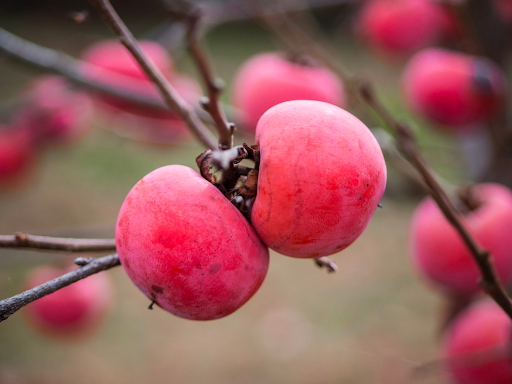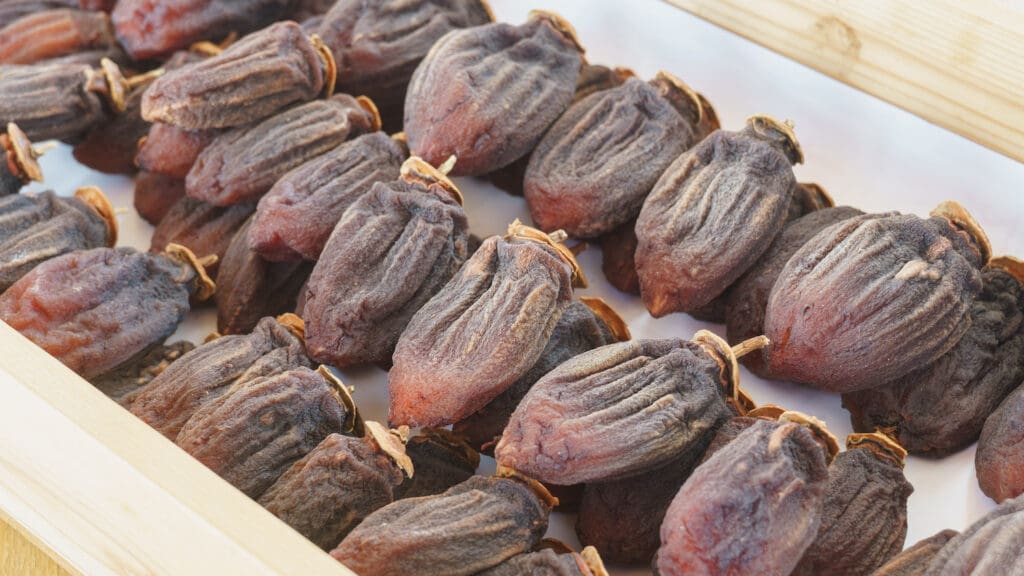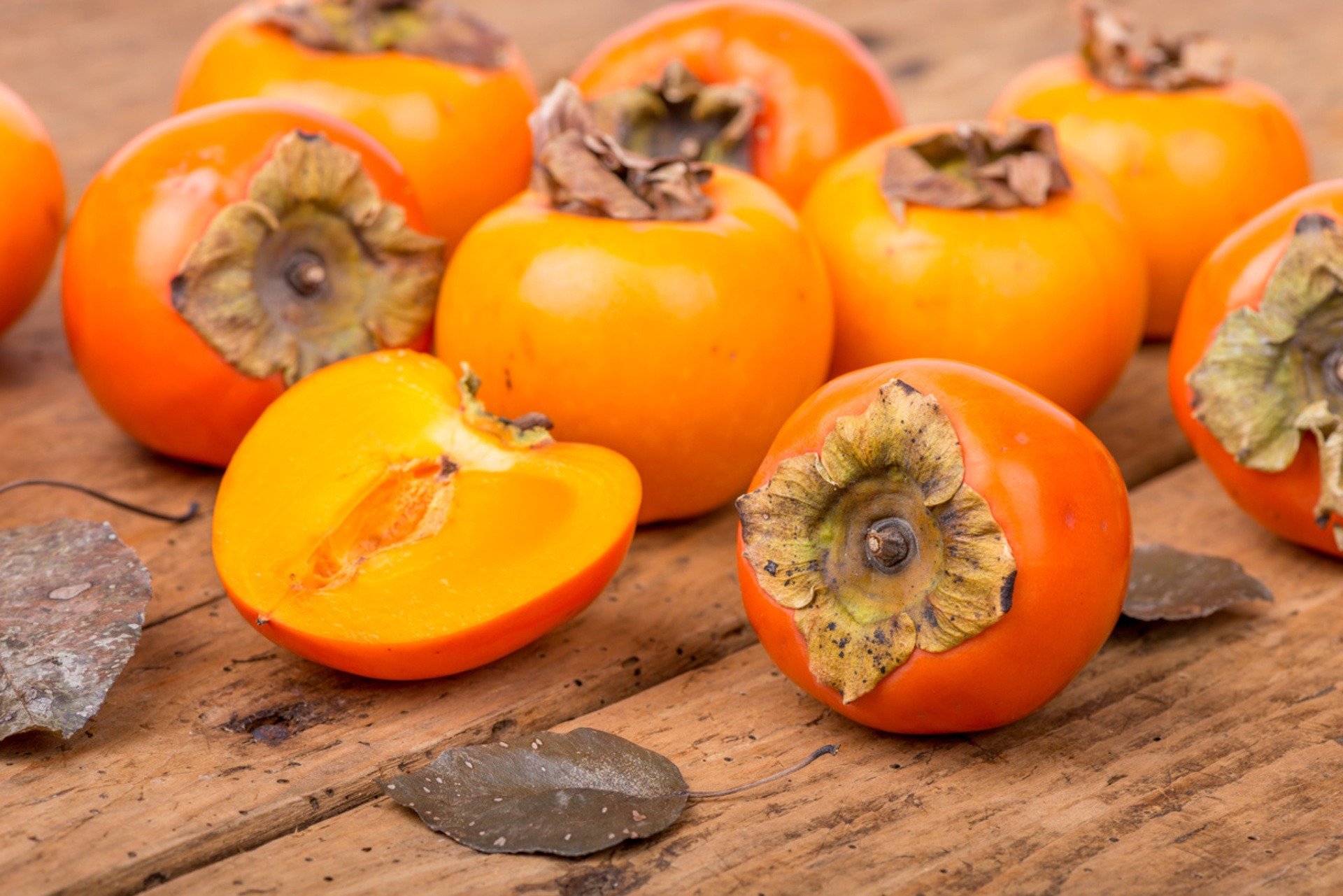Eat seasonally this winter with persimmons
Why do persimmons inspire such devotion? People talk of them with the reverence they would other fleeting produce delicacies, like ramps or sour cherries; chefs lie in wait for the first of the season to arrive. Social media is filled with pictures that accentuate their stunning hue, which has even been predicted as a color of the year for 2024.
Certainly, the flavor of a persimmon is something special — so special that it can’t always be summed up succinctly. Liz Bendure, chef-owner of Chicago’s Txa Txa Club, describes persimmons as “fruity and musky like papaya and kiwi” but “savory, too, like avocado.” Txa Txa’s other chef-owner, Daniel Parker, meanwhile, thinks of them like “a cross between ripe banana or mango and peak-season tomato with a dash of nutmeg.” Last January, the pair threw an entirely persimmon-themed dinner to celebrate the fruit’s many facets. (On the menu: persimmon carpaccio, baked persimmon fazzoletti and furikake made with dehydrated persimmon skins.)
But the main reason we love persimmons is that elusive pleasure — a winter fruit — adding some much-welcome color and sweetness to a time of hardy vegetables and tubers. (As Parker puts it, a persimmon is like “an icebox plum mid-summer, but in January.”) In much of the U.S., the season spans from late fall through February or so, though Californians especially can count on a few additional months on either end. Here’s how to make the most of this seasonal delicacy.
Need-to-know varieties
Persimmons in this country are still, in some ways, a minor fruit. “As I see it, persimmons are very much a specialty or alternative crop in most of the United States, outside of the Southwest,” says Missouri persimmon farmer Weston Adams. “For various reasons they have not caught on commercially in most of the United States.” The majority are grown in California and Florida, and of these, most are Diospyros kaki, commonly known as Asian persimmon. Ubiquitous across China, Korea and Japan, it’s also usually the only persimmon species in U.S. supermarkets.

There are two varieties that any persimmon neophyte should familiarize themselves with: Fuyu and Hachiya. While both are D. kaki, they vary not only in appearance — Fuyus are squat and round, Hachiyas larger and more oblong — but also in how they behave. When raw, Hachiyas are famously astringent (a measure you’ll hear often in reference to persimmons) due to the presence of tannins, which mellow as the fruit ripens to its characteristic jelly-like consistency. Fuyus, on the other hand, don’t have the same mouth-puckering effect, and can be eaten raw at any stage of ripeness.
Limited commercial importance aside, Asian persimmon varieties can grow well in much of the country (USDA hardiness zones 7 to 11, according to the National Gardening Association), meaning it’s not out of the question to find these at your local farmers’ market if you come at the right time of year. In fact, most of the persimmons grown for food in the U.S. come from very small farms; persimmon trees have few pests, are impacted by few diseases and are quite adaptable to different growing conditions, so growing organically is not a huge lift. Many growers, Adams says, “will tell you that persimmons are one of the few fruits they can grow without pesticides and other chemicals.”
Still, Asian varieties tend to not be winter hardy in our climes, so the season for them is as short as it is sweet. A lot of them, Adams explains, “will die if winter temperatures dip much below zero — even for one night.”
Expanding options
Though much of the persimmon conversation does revolve around Fuyu vs. Hachiya, there are — as with so many other fruits and vegetables — a huge number of lesser-known varieties that should be on your radar. Seed Savers Exchange actually recorded 123 in its 2015 Nursery Trade Census. Aside from the big two, there are many distinct and delicious cultivars under the Asian persimmon umbrella: Giombo, Saijo, Rojo Brillante, Triumph and more.
But it’s also worth paying attention to our very own native species. Diospyros virginiana, the American persimmon, grows wild along the Eastern Seaboard and west as far as Kansas. Its fruits tend to be smaller than Asian varieties, and are astringent like Hachiyas, so must spend time ripening before showing their true colors. According to the Slow Food Ark of Taste, this “distinctively American fruit” was used historically by Indigenous Americans (the word “persimmon” has Algonquian roots, linguistically), and later European colonists and enslaved Africans. People found countless uses for these wild persimmons: drying them for storage or transport, using the pulp to sweeten desserts, roasting the seeds for making a coffee-like beverage.
These days, D. virginiana continues to grow wild and is also used as an ornamental plant (both Asian and American persimmons are gaining popularity as backyard trees). But crucially, these trees are more winter hardy and adaptable to more U.S. climates than the better-known D. kaki varieties — and could present opportunities for commercial cultivation.
“Many breeders, including myself, are interested in using genetics from the wild American persimmon to increase the cold-hardiness of non-astringent Asian persimmon varieties.”
“To my knowledge there are no publicly funded persimmon breeding programs in the United States,” Adams notes. However, there are many passionate hobbyists and farmers experimenting with American cultivars and hybrids. “Many breeders, including myself, are interested in using genetics from the wild American persimmon to increase the cold-hardiness of non-astringent Asian persimmon varieties,” says Adams, who also sells grafted trees — interested parties can message on Facebook — and is coordinator of a USDA grant project on the subject that’s currently underway.
How to handle ‘em
As we’ve said, Persimmons can generally be divided into astringent and non-astringent, though the former tend to outnumber the latter. Fuyus can be eaten fresh and crunchy and are often best before they start to get soft. But the first step in cooking with many other varieties is one that involves very little effort at all: waiting. For Hachiyas and American persimmon varieties, for example, the texture should ideally be soft and supple, as though the skin is in danger of bursting.
If you’re in a hurry, try the old trick of placing your fruits in a paper bag with a banana or apple — the ethylene gas they emit will speed things up. Freezing and defrosting will help soften the flesh, but won’t get rid of the astringency. All in due time. As Bendure puts it: “Buy them early, let them sit. Leave them be until they are ripe.”
Jeremy Shigekane, executive chef at Honolulu’s 100 Sails, cautions that when working with the fruit, home cooks should be aware of both “the flavor differences between the variety of persimmons, and how to use the fruit during the different stages of ripeness.”
Fuyus, for example, will be firm enough to be sliced for salads or cheese plates, chopped up into batters or halved to lay across the top of a cake. But good luck cutting into a ripe Hachiya: Because they’re so soft, they are best used for mixing into doughs or sauces and glazes. “You’ll need to peel and puree them first (and also strain out the seeds and any stems),” Shigekane explains.
Endless eating possibilities
When Samantha Shankman, founder of Farm Hospitality, moved onto the biodynamic farm in Spain where she now lives, she discovered a persimmon tree thriving on the land. Others told her it was called “caqui,” which she would later learn was simply the Spanish word for the fruit and not an unusual Iberian plant. Shankman isn’t sure of the variety — she guesses Rojo Brillante — but persimmons are now a reliable part of her fall and winter harvest.
One of Shankman’s favorite ways to eat them is just as they are: “using a knife to cut open the top and then taking a spoon to scoop out the insides like nature’s pudding.” After a few harvests, she started experimenting with cooking them — roasting them to pair with jamon serrano, using them to enhance the flavor of meat dishes. “My favorite is to add it to roasted butternut squash,” she says, which is harvested around the same time.
Persimmons shine in dishes that play up the cozy, cold-weather, autumn-spice side of things. “Hachiya persimmons have almost a mild pumpkin-like flavor and remind me of the fall,” says Shigekane, noting that persimmons “pair extremely well with flavors like nutmeg and cinnamon” and other ingredients with a “slight bitterness to offset the natural sweetness,” such as cocoa nibs or lapsang souchong.
Asian persimmons, naturally, feature in many East Asian cuisines: Try them in shi zi bing, Chinese persimmon cakes; kaki no shira-ae, a Japanese tofu-persimmon salad; or sujeonggwa, a Korean persimmon-spice tea. No time for cooking? Persimmons can also be treated simply, drizzled with olive oil, layered with mascarpone on toast or, Bendure’s recommendation for Hachiyas, spooned perfectly ripe over soy sauce-seasoned rice. (“It rides the sweet and savory line so perfectly well.”)
Persimmons can also be pickled, made into candy, turned into jam or preserved in various other ways. One of our favorite methods is hoshigaki, a Japanese method that not only creates a beautiful result, but adds some beauty to the home with its garlands of golden-orange fruit strung up to dry.
Below, a recipe from IACP Award-winning cookbook author Sonoko Sakai, who hosts workshops in hoshigaki-making and other Japanese scratch cooking techniques out of her Los Angeles studio. “Every December, for more than fifty years, my parents would receive a package of hoshigaki…in the mail from my old Japanese language tutor who lives in Ogaki, in Gifu Prefecture in the center of Japan,” she writes in her book “Japanese Home Cooking.” “ I have turned hoshigaki making into a fall tradition.”

Recipe: Hoshigaki (Dried Persimmons)
Sonoko Sakai, “Japanese Home Cooking: Simple Meals, Authentic Flavors”
Makes 24
Equipment and ingredients
Bucket (metal or plastic)
Box of noncorrosive stainless-steel screws (24 screws)
Kitchen string
Laundry rack or rod to hang the persimmons
Small fan
Newspaper to line the floor
24 red Hachiya persimmons, firm or slightly soft to the touch and dark orange in color, with ½ inch (12 millimeters) of the branches attached
Method
- Wash the fruit in a bucket of water and dry with a towel. Sort them by size — large, medium, and small. It is best to use larger persimmons, which will allow for more shrinkage.
- To trim the calyx (the fruit cap that protects the bud and to which the stem is attached), hold the fruit with one hand and a paring knife with the other. Insert the tip of the knife at an angle so it comes out in front of the stem. Using the hand that is not holding the knife, rotate the fruit and cut all around the calyx to remove the peel. If a stem is missing from a persimmon, use a stainless-steel screw; simply screw it gently into the top of the fruit where the stem was.
- Cut lengths of kitchen string to about 18 inches (46 centimeters) long; you’ll be attaching one persimmon to each end of the string. Aim to have a pair of persimmons of similar size on each string.
- Using a slip knot, tie the ends of the strings to the stem (or stainless-steel screw) of each fruit. Trim the short ends with scissors so they don’t touch the fruit.
- Bring a medium pot of water to a boil and dip the fruit in it for 3 seconds. This will sterilize and kill any bacteria — an important step before you dry the fruit.
- Hang the tied fruit on a rack, making sure the persimmons are not touching one another. Put the rack close to a sunny window. The rack can be placed outside during the day but must be brought inside at night. Put a newspaper underneath the fruit to catch any dripping juice or fallen fruit. Place a small rotating fan in the room near the persimmons to speed up the drying process and maintain good air circulation; the fan will also keep fruit flies away.
- After a week, check to see if the fruit is dry. If it is dry to the touch, start massaging it. Begin with just a gentle touch once a day—do not squeeze—and work your way up to a gentle massage, but no squeezing. The fruit will start to soften and shrivel. If you see any mold (white or black spores) forming, scrape it away and dab a bit of vodka or other clear liquor in the area. Tie the remaining fruit to the rack and allow it to dry.
- Repeat this daily massage for 3 to 4 weeks, until the fruit feels firm but with some softness remaining inside. Cut a piece and taste it. If it is raisin-like in chewiness and sweet, the persimmon is ready. A white coating forming on the surface of the fruit is the natural sugar crystalizing, so don’t confuse this coating with mold. The coating is a sign that the fruit is drying properly.
- Remove from the rack and store in a plastic container or bag in the refrigerator or freezer. It will keep for up to 1 year. You can enjoy it straight — it is great with blue cheese — or steeped as tea with some cinnamon sticks, sliced ginger, and honey.
Excerpted with permission from “Japanese Home Cooking: Simple Meals, Authentic Flavors” by Sonoko Sakai. Roost Books, 2019.
Get the latest food news, from FoodPrint.
By subscribing to communications from FoodPrint, you are agreeing to receive emails from us. We promise not to email you too often or sell your information.
Top photo by alexeyborodin/Adobe Stock.
More Reading
15+ ideas for delicious meatless grilling
July 1, 2025
4 Tips for Stretching Your Food Dollars
April 16, 2025
How to use extra onions
April 9, 2025
Our latest podcast episode on pistachios: The making of a food trend
April 1, 2025
This vegan tiramisu will bring you joy
March 11, 2025
For lessons in thrifty, climate-friendly cooking, look to vintage cookbooks
March 10, 2025
Americans love olive oil. Why doesn't the U.S. produce more of it?
February 28, 2025
How to fight household food waste? Join our Eat Down Your Pantry Challenge!
February 13, 2025
During a period of egg chaos, egg replacements for (almost) any situation
February 7, 2025
Ways to go meatless — or less-meat — in January
January 15, 2025

